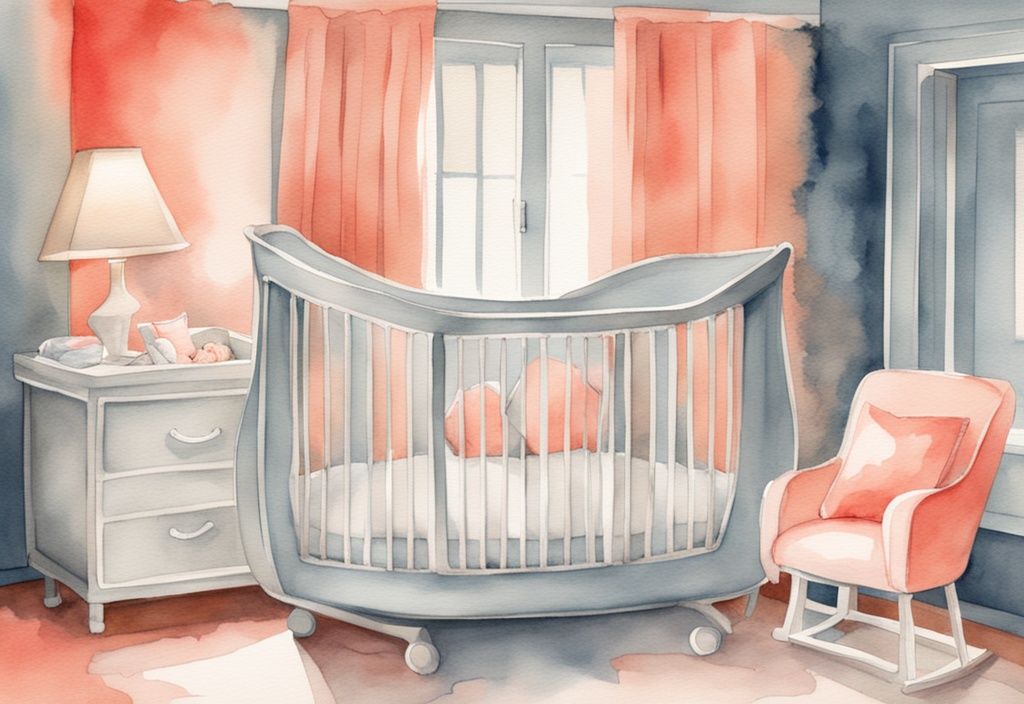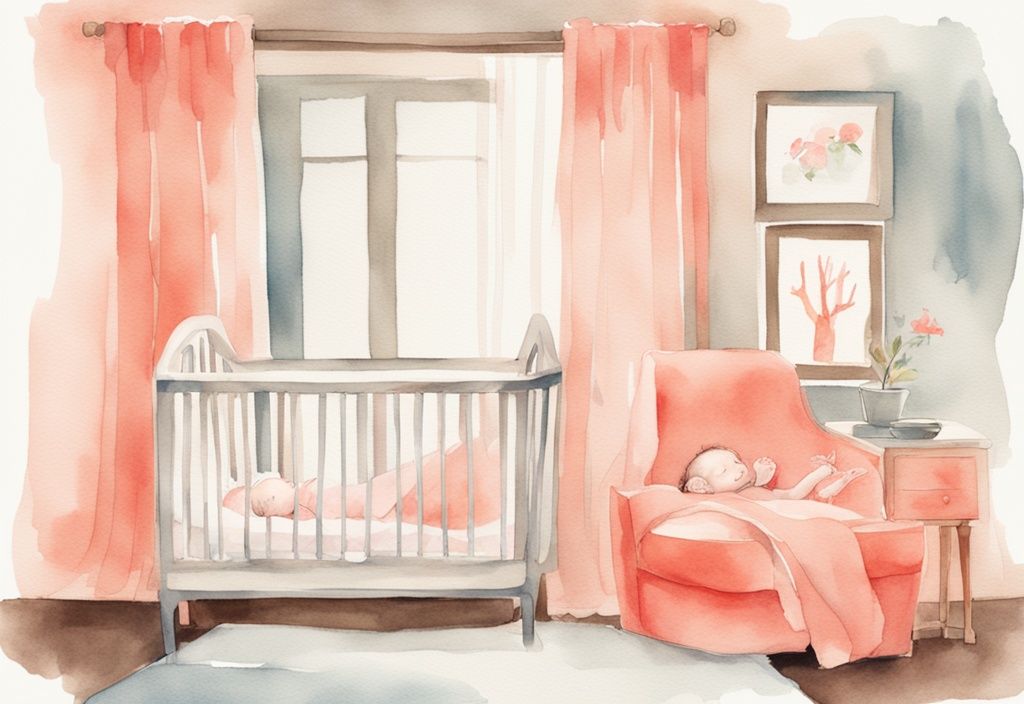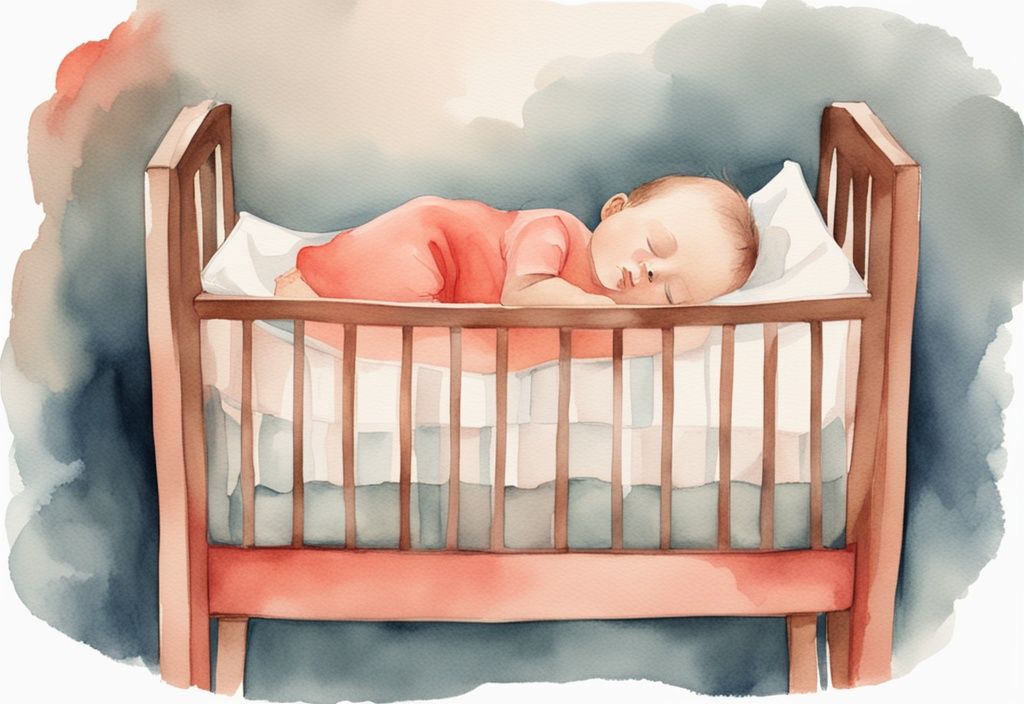Hey there, fellow sleep-deprived parent! Are you wondering how to get your newborn to sleep in a bassinet? Trust me, I’ve been there. It’s a common challenge we all face, but don’t worry, I’ve got some tried-and-true tips to share.
In this guide, we’ll explore practical strategies to create a safe and comfortable sleep environment for your little one. We’ll discuss everything from establishing a calming routine to ensuring safety, all aimed at making bedtime smoother for both you and your baby.
So, let’s dive in and discover how to foster a peaceful sleep setting, ensuring your newborn rests soundly and securely in their bassinet. Here’s to better nights and happier mornings!
Understanding the Importance of a Bassinet
A bassinet is more than just a piece of baby furniture; it’s a cozy little nest that can make a world of difference for both you and your newborn. Let’s explore why it’s such a cherished sleeping option and how you can prepare it to ensure safe, restful nights for your little one.
Why a Bassinet is a Safe and Convenient Sleeping Option
Ah, the bassinet—a parent’s best friend in those early days! It’s compact and portable, making it a dream for those late-night feedings and sleepy check-ins. Imagine having your baby right by your side, nestled in a snug environment that feels just like home to them. This familiarity can be incredibly comforting for newborns, helping them adjust to life outside the womb.
For those of you wondering how to get a newborn to sleep in a bassinet, remember that its proximity not only makes nighttime care easier but also strengthens that precious bond between you and your baby. The American Academy of Pediatrics gives a thumbs-up to using a bassinet with a firm mattress and a fitted sheet—no fluffy blankets or pillows, please! These safety measures are crucial, especially when room-sharing, which is recommended for at least the first six months to greatly reduce the risk of Sudden Infant Death Syndrome (SIDS).
Preparing the Bassinet for Safe Sleep
Now, let’s talk about setting up that bassinet for safe and sound sleep. Keeping it clean and using a firm mattress with a fitted sheet designed for your specific model is key. This setup minimizes the risk of suffocation and keeps your baby safe and snug.
If you’re scratching your head over how to get a newborn to sleep in a bassinet, here’s a golden tip: always place your baby on their back, with those tiny feet touching the end of the bassinet. Not only does this promote safe sleep, but it also helps prevent any accidental rolling over.
And don’t forget to keep an eye on the bassinet’s weight limits. If your little one starts to outgrow it or seems uncomfortable, it might be time to transition to a crib. Remember, parenting is a journey filled with adjustments, and that’s perfectly okay!
Creating a Conducive Sleep Environment for Newborns
Understanding how to get a newborn to sleep in a bassinet involves creating a nurturing and safe sleep environment. This section covers essential tips and tricks to help your little one drift off peacefully.
Maintaining the Ideal Room Temperature
When it comes to getting your newborn to sleep in a bassinet, room temperature plays a starring role. Aim for a cozy 68-72 degrees Fahrenheit (16-20 degrees Celsius). This sweet spot helps ensure your baby isn’t too hot or too cold, which can lead to restless nights. Dress your little one in layers that match the room’s temperature. Think of it like Goldilocks—just right! Too many layers can lead to overheating, while too few might leave your baby chilly.
Using White Noise and Dim Lighting
White noise and dim lighting can be your best allies in the quest for bassinet sleep success. A white noise machine can work wonders by masking disruptive sounds and mimicking the comforting whoosh of the womb. It’s like a lullaby for the senses! Meanwhile, keeping the room dim with soft lighting or blackout curtains signals to your baby that it’s time to snooze. This helps establish a clear day-night difference, encouraging longer stretches of sleep. And let’s be honest, who doesn’t love a good nap?
Ensuring the Bassinet is Comfortable and Safe
Comfort and safety are key when figuring out how to get a newborn to sleep in a bassinet. Start with a clean, firm mattress and snug-fitting sheets to avoid any safety hazards. It’s all about creating a cozy nest! Experiment with different setups, like removing unnecessary inserts, to find what makes your baby feel most at ease. Here’s a little trick: sleep with the baby’s mattress sheet before using it. Your scent can be incredibly comforting, helping your newborn feel secure and snug in their bassinet. It’s like giving them a gentle hug all night long.

Establishing a Consistent Sleep Routine for Your Newborn
Creating a consistent sleep routine for your newborn can feel like a daunting task, but it’s all about finding what works for you and your little one. In this section, we’ll explore some gentle strategies that can help your baby settle into their bassinet, ensuring both of you get the rest you need.
Recognizing and Adhering to Wake Windows
Understanding your newborn’s wake windows is a game-changer when figuring out how to get a newborn to sleep in a bassinet. These are the magical periods when your baby is awake and alert before they start showing signs of fatigue. By tuning into these windows, you can avoid the overtiredness that often turns bedtime into a battle. During these wakeful moments, make sure to cover all the basics: feeding, changing, and a bit of playtime. This rhythm helps create a predictable pattern, making those transitions to naps and bedtime smoother. And trust me, it makes a world of difference when you’re trying to get your newborn to sleep in a bassinet.
Creating a Calming Wind-Down Routine
Ah, the power of a calming wind-down routine! It’s like a gentle nudge telling your baby it’s time to drift off to dreamland. Establishing a consistent pre-sleep ritual can work wonders in your quest for how to get a newborn to sleep in a bassinet. Think of soothing activities like a little lullaby, a short story, or some cozy cuddling. Maybe even a warm bath followed by a feeding session to help your baby relax. The trick is to lay them down while they’re drowsy but still awake, helping them associate the bassinet with sleep and self-soothing. This routine not only promotes better sleep but also fosters a sense of security and comfort in their bassinet haven.
Effective Techniques to Help Your Newborn Sleep in a Bassinet
When it comes to figuring out how to get a newborn to sleep in a bassinet, it can feel like a puzzle with many pieces. From creating cozy sleep associations to gently transitioning your little one from your arms to the bassinet, these techniques are all about making bedtime a peaceful and comforting experience for both you and your baby.
Placing Baby Drowsy but Awake
One of the golden nuggets in understanding how to get a newborn to sleep in a bassinet is the “drowsy but awake” trick. Picture this: your baby, calm and drowsy, is gently placed in the bassinet. This helps them link the bassinet with sleep, nudging them towards settling down on their own. While those self-soothing superpowers usually kick in around 4-6 months, starting early with this habit can work wonders in the long run. It’s like planting seeds for better sleep patterns and self-soothing abilities that will blossom over time.
Using Swaddling and Pacifiers
Ah, swaddling! It’s like giving your baby a warm hug that reminds them of the cozy womb. This age-old technique can be a game-changer in mastering how to get a newborn to sleep in a bassinet. By snugly wrapping your little one in a blanket, you help reduce those startle reflexes and encourage longer sleep stretches. Here’s a quick swaddling tip: lay a blanket flat, fold down a corner, place your baby with their head above the fold, wrap one side over, tuck it under, bring up the bottom, and wrap the other side. Voilà!
And let’s not forget the magic of pacifiers. They can be a soothing companion, helping your baby feel secure. Just a heads-up: it’s best to introduce them after breastfeeding is well-established to avoid any nipple confusion.
Gradual Transition from Arms to Bassinet
Many parents find that when learning how to get a newborn to sleep in a bassinet, a gentle transition from arms to bassinet works best. Start by letting your baby spend short, awake periods in the bassinet during the day. Gradually increase this time, helping them get familiar with their new sleep spot. If your baby dozes off in your arms, wait for that deeper sleep before the transfer. And here’s a little trick: lower their feet first when placing them down to avoid any startling.
This gradual approach helps your baby feel secure and comfy in their bassinet, paving the way for better sleep habits. Remember, it’s all about making bedtime a soothing journey, one gentle step at a time.

Addressing Common Challenges in Getting Newborn to Sleep in a Bassinet
Helping a newborn settle into a bassinet can feel like an uphill battle, but understanding the common hurdles can make a world of difference. From dealing with reflux to responding to those heart-tugging nighttime cries, each challenge comes with its own set of solutions. Let’s dive into some practical tips and heartfelt advice to make this transition smoother for you and your little one.
Dealing with Reflux and Discomfort
Oh, reflux! It’s one of those pesky issues that can make bassinet sleep tricky for your newborn. One thing I’ve learned is the magic of feeding your baby in an upright position. Trust me, it works wonders. And don’t forget to burp them often—those tiny tummies need all the help they can get. Keeping your baby upright for about 20-30 minutes after feeding can really ease their discomfort. Planning feeding times is also key; it helps prevent overfeeding, which can make reflux worse. These small steps can create a cozy, comfy environment and are essential in figuring out how to get a newborn to sleep in a bassinet.
Handling Startle Reflex and Sleep Regression
Ah, the startle reflex and sleep regression—two things that can really throw a wrench in your baby’s bassinet sleep. Swaddling has been my go-to trick for minimizing that startle reflex. It gives babies a snug, secure feeling, almost like a gentle hug. It’s amazing how such a simple technique can help your little one sleep more soundly. By understanding these challenges and tackling them head-on, you can make a big difference in your baby’s sleep patterns and their overall comfort in the bassinet.
Responding to Nighttime Cries Effectively
Those nighttime cries can pull at your heartstrings, can’t they? But learning how to respond effectively can help your newborn feel safe and snug in their bassinet. Observing your baby while they sleep is a great way to understand their needs without rushing to pick them up at the first cry. Try soothing techniques like gentle patting, a soft tummy rub, or even a little lullaby. These comforting responses can help your baby associate the bassinet with safety and warmth, making it easier for them to drift off to dreamland.
Understanding Every Baby is Different: Patience and Persistence
Every baby is a little bundle of uniqueness, especially when it comes to sleep. As you embark on the journey of figuring out how to get your newborn to sleep in a bassinet, it’s important to remember that patience and persistence are your best friends. Babies have their own sleep rhythms, and what works for one might not work for another. Embrace this adventure with an open heart, knowing that your little one will find their way to dreamland in their own time.
When to Seek Professional Advice
Now, let’s talk about the times when you might need a little extra help. If your baby is having a tough time settling in the bassinet night after night, it might be a good idea to reach out to a pediatrician or a sleep consultant. These professionals can offer tailored advice, helping you uncover any underlying issues that could be affecting your baby’s sleep.
Remember, you’re not alone in this. Seeking professional guidance doesn’t mean you’re not doing a great job. It just means you’re being proactive about creating a peaceful sleep environment for your little one. And that’s something to be proud of!
As you try different techniques, keep in mind that consistency is key. It might take a few tries to find the right approach that makes your newborn feel snug and secure in their bassinet. But with a little patience and a lot of love, you’ll get there.
So, take a deep breath, trust your instincts, and know that you’re doing an amazing job. After all, parenting is a journey filled with both challenges and triumphs, and you’re navigating it beautifully.

FAQ
Welcome to our FAQ section, where we dive into common questions and concerns about how to get your newborn to sleep in a bassinet. Let’s explore practical tips and heartfelt advice to help you and your little one find peaceful sleep.
What is the ideal room temperature for a newborn’s sleep?
Finding the right room temperature can be a game-changer. Aim for a cozy 68-72 degrees Fahrenheit (16-20 degrees Celsius). This sweet spot helps keep your baby snug without overheating. Think of it as creating a little haven of comfort for your precious one.
How can I help my newborn self-soothe in the bassinet?
Ah, the art of self-soothing! It’s like teaching your baby a gentle lullaby. Try laying your baby down drowsy but awake. This helps them learn to drift off on their own. A pacifier or some white noise can work wonders, creating a soothing symphony that lulls them into dreamland.
Why does my newborn wake up as soon as I put them in the bassinet?
This is a common hiccup, and you’re not alone! Your little one might be seeking comfort or reacting to the startle reflex. To ease the transition, try placing them in the bassinet for short, awake periods during the day. It’s like introducing them to a new friend gradually.
Is it safe to use a pacifier for a newborn sleeping in a bassinet?
Absolutely, pacifiers can be a great comfort tool. Just remember, it’s best to introduce it once breastfeeding is well-established to avoid any confusion. Think of it as a little helper, offering comfort when needed.
When should I transition my baby from a bassinet to a crib?
Every baby grows at their own pace, but when they start outgrowing the bassinet’s weight limits or seem a bit cramped, it might be time for a crib. It’s all about ensuring they have enough room to stretch and sleep safely. Consider it a new chapter in their sleeping adventures!
Conclusion
Getting a newborn to sleep in a bassinet is a journey that requires time and dedication. It’s important to understand that consistency is key. Establishing a routine not only helps your baby feel secure but also fosters a sense of predictability, comforting for both your little one and you. Remember, safety should always be a top priority. Make sure the bassinet is set up correctly with a firm mattress and fitted sheet, free from any potential hazards like loose blankets or toys.
Comfort is another crucial aspect when considering how to get a newborn to sleep in a bassinet. Creating a soothing environment with the right temperature, dim lighting, and perhaps some gentle white noise can make a significant difference. These elements help mimic the womb’s conditions, making the transition to sleeping in a bassinet smoother for your baby.
Patience and persistence are essential. Every baby is unique, and what works for one might not work for another. Be prepared to try different strategies and remain flexible in your approach. Tailoring methods to suit the individual needs of your baby can lead to more successful outcomes. Remember, this is a learning process for both you and your baby, and with time and effort, a peaceful sleep routine can be established.


